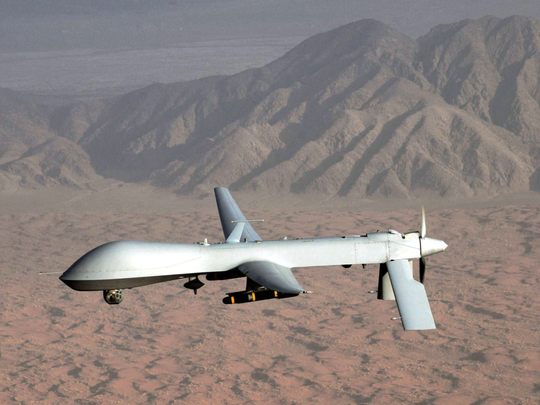
US President Barack Obama regards drones as a welcome addition to warfare, a relatively cost-free form of conflict, at least in terms of American casualties. Drones offer an attractive option to a president who came to power in 2008 pledging to withdraw American combat troops from unpopular wars in Iraq and Afghanistan.
Al Qaida and other American enemies could still be confronted, with death dispensed from the air, but there would be no American troops coming back in body-bags.
In a speech in 2013 , Obama lauded drones as “precision” weapons, much more discriminate than strikes by planes or cruise missiles, thus reducing the chance of civilian casualties. Drone operators, he said, had to have “near certainty” that no civilians would die in strikes.
Obama has the backing of the US intelligence community who argue that drones have been effective, successful in eliminating much of the Al Qaida command and support based in Pakistan’s federally administered tribal areas. While Al Qaida still poses a threat, it is a much diminished one, they say.
They also claim successes in Afghanistan, Yemen and Somalia, though to a lesser extent.
There is a big hole in this narrative, though, as Intercept reporter Jeremy Scahill graphically described in a series of leaked drone documents published last Thursday. The documents contradict Obama’s insistence that strikes will not be made unless there is “near certainty” that there will be no civilian casualties.
Scahill has written before about the flakiness of targeting policy, about how drones are fired at the holder of a mobile phone that might once have been owned by a suspected terrorist but could now be held by someone different, someone entirely innocent. But these latest documents provide much more detail about just how unreliable the intelligence is, often based on faulty communications data.
Al Qaida threat
The documents also confirm that the strikes often involved high civilian death tolls. The Bureau of Investigative Journalism, which has been tracking casualties, lists 421 US drone strikes in Pakistan since 2004 which have resulted in an estimated 2,476 to 3,989 deaths, of whom 423-965 were civilians, 172 to 207 of them children.
Hardened US intelligence analysts might regard this as a price worth paying for reducing the threat posed by Al Qaida.
The question not answered is how many of these civilian deaths contribute to a new generation of militants, family members bent on revenge.
In addition to the issue of the legality of such strikes, which is a long way from being resolved, there is also a question about the limitations of drones.
US drone strikes in Iraq and Syria seem to have made no significant impact on Daesh (the self-proclaimed Islamic State of Iraq and the Levant). More than a year after Daesh took Mosul in northern Iraq, they have lost some ground but compensated with gains elsewhere, such as taking Ramadi.
In the end, the only way Daesh can be defeated will be when it is confronted by ground troops. The US will not put them in, hoping instead that one of the regional forces will do so instead.
Obama, the Nobel peace prize winner, embraced drones as a solution to his military problems, ordering many more strikes than his predecessor George W Bush. But drones have only a limited role. And, as the US might yet discover, they are far from cost-free.
— Guardian News & Media Ltd









